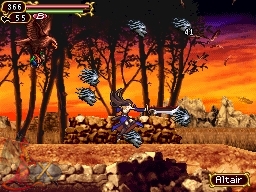|
|

|
PLATFORM
|
DS
|
BATTLE SYSTEM
|

|
INTERACTION
|

|
ORIGINALITY
|

|
STORY
|

|
MUSIC & SOUND
|

|
VISUALS
|

|
CHALLENGE
|
Moderate
|
COMPLETION TIME
|
Less than 20 Hours
|
|
OVERALL

|
+ Same old 2D Castlevania platforming
- Same old 2D Castlevania platforming, after all these years?
+ Great music, like always.
+ Attacks costing MP is really obnoxious
- Poor dungeon design
- Feels like a huge regression for the series
|
Click here for scoring definitions
|
|
|
A little over a decade ago, a man named Koji Igarashi saved a 10-year old platformer series which was becoming repetitive and falling behind its competition. That series was Castlevania, and the game that marked the huge turning point was Castlevania: Symphony of the Night. It was a complete overhaul of the series which had grown stale over time; yet, the new gameplay and aesthetics felt exactly like the old Castlevania. Now, eleven years later, Igarashi has produced several Castlevania games - most of them being 2D games in the same vein as Symphony of the Night. Not surprisingly, the game which started it all has been surpassed, and the series has still seen many innovations.
However, it's now been eleven years since then, and the newest installment, Order of Ecclesia, gives me a strange feeling. Way back before SotN, Castlevania had fallen into some pretty severe repetition, and wasn't giving its fans many new innovations to write home about. They were still fun, no doubt; but they were going nowhere after a while. I'm sure this is probably what was going through the minds of the brains behind SotN. Now, I wonder if the same thoughts are crossing their minds, because Order of Ecclesia reminds me of all the thoughts and feelings I just shared - a fun game, but an act that's growing tired after all these years.
That's not to say the game is bad, by any stretch - it's hard to dislike a 2D Castlevania game, cos they're so simple and addicting. Castlevania: Order of Ecclesia (as well as almost all of its predecessors for the last eleven years) plays like a 2D action platformer at its core. On top of that, you gain experience points to level up the character you use, much like any normal RPG. As your main character - a lady simply named Shanoa - you just trek through dungeons, fight bosses, and learn new abilities on your way to find Dracula and kill him, as you always do in the Castlevania games.
...Well, sort of. Order of Ecclesia's story unfolds as Shanoa is sent out by an organization called Ecclesia to reclaim a stolen spell called 'Dominus' - the only thing which can stop Dracula from being reborn again. The story isn't all that great, but the game never has any such delusions in the first place. It's simply a means to creating a gothic 2D platforming with horrifying monsters.
Another point of aberration between Order of Ecclesia and its ilk is the game's level (as in, the locations you go to, not RPG levels) system. Most of the games take place entirely in Dracula's castle (or a likeness of Dracula's castle, in one of the games). While Order of Ecclesia's second half takes place there (Spoilers? Yes. Big surprise? No.), the first half has you going through different locations, like mountains, rivers, and other weird places to find demons.
 See? The dungeons are straight lines!
See? The dungeons are straight lines!
|
|
Strangely enough, while this is technically a new thing, the levels that appear outside of Dracula's castle look mostly like places from previous games, i.e places that you visited in Dracula's castle at some point in the series. For the most part, it feels as if the gameplay idea of NOT being in Dracula's castle the entire time was wasted due to that aspect. Nevermind that about 1/4 of the 'outside' dungeons are laid out in a straight line. How interesting!
The big innovations to gameplay are the Glyph system and the Combo system. The Glyph system is simple: Shanoa can equip three Glyphs - abilities that you get from monsters after defeating them. There are two slots for attack Glyphs, and a third slot for miscellaneous Glyphs, which allow you to raise parameters, summon/transform into monsters, and even supplementary abilities like walking through walls. Each of these take a certain amount of MP, but that's pretty irrelevant, as your MP recharges absurdly fast. You have a separate type of MP called Hearts, however, which you use to perform special attacks with your equipped Glyphs. If you equip specific pairs of Glyphs together, you will get a Glyph Union - a highly damaging special attack.
The Combo system is even simpler: Your attack Glyphs are each assigned to different buttons, and you can quickly alternate attacks between the two. Big whoop. What keeps this from being completely broken is that your Glyphs take MP to use, preventing you from just spamming attacks at light speed for as long as you want.
"So, this sounds cool, actually. What's the big problem?" Well, they aren't big problems, actually. There's two small things that grate on my nerves:
1. In most 2D Castlevanias, you equip weapons to supplement your spells/Glyphs/Souls/whatever they're called in that particular game. In Order of Ecclesia, though, your weapons ARE Glyphs. What effect does this technically have on the game? Not much. I'm sure no one else will be bothered by this, but it seems like this takes away from what could have been a lot more super-cool magic Glyphs. Instead, about 40% of your Glyphs are actually just weapons. As an added annoyance, the status effect 'Curse', which slowly drains your MP, renders you unable to attack as soon as your MP runs out, since even your physical attacks are magic! Curse was in other games, but this problem never existed before.
 For better or worse, it's exactly what you might expect of a new Castlevania game.
For better or worse, it's exactly what you might expect of a new Castlevania game.
|
|
2. The Glyph system is a less-developed ripoff of the 'Soul' system in Castlevania: Aria of Sorrow and Castlevania: Dawn of Sorrow. Again, this isn't SUCH a huge deal - for one, you're allowed to rip your own ideas off; and, it's a damn good system. The problem is, this makes the game feel a lot more like a step backward. Aria of Sorrow originated the idea, and Dawn of Sorrow perfected it. Since then, new innovations have sprung up in the series that have yet to fulfill their full potential, so why go back to something that seriously could not get any better?
But, overall, these are trifling complaints. The game plays very well, and a lot of minor problems from older games have finally been fixed, so there is a certain degree of polish to the game in comparison to the other recent installments. The game is fairly challenging, has cool music and graphics, and it's a lot of fun to go exploring all the various locations of the game.
Still, something about this game just keeps nagging at me. It feels like - besides the very minor polishes that most people probably won't even notice - I've seen it all before. It's one thing to revisit an old idea if you think you can do it better - Dawn of Sorrow proved this by taking the amazing system of Aria of Sorrow and realizing it to its fullest potential. This, however, feels like a step BACK from Dawn of Sorrow, or maybe even like a step back from Aria of Sorrow. Other than that, all the nice things I have to say about this game? You can say that for about 90-95% of all Castlevania games created since 1997.
All this adds up to one thought: What's next for Castlevania? Probably nothing new - they'll probably just keep going down this route, since it's making money for them. However, I think the time is nigh for either a second drastic overhaul of the series, or a better realization of Castlevania in 3D. Honestly, I'll take the latter, since they've already got the most important part - excellent core gameplay and controls - down pat. All they need to do now is make a game that doesn't have such a horrid cast of characters, and maybe make the environments look a bit less repetitive - not because they need it, but because haters of the 3D Castlevania games won't stop complaining about it. The irony is that the 2D Castlevania games not only have equally repetitive environments (similar-looking rooms, and some dungeons are merely pallete swaps!), they even go the extra mile and reuse the same ideas for dungeons from game to game(Yeah, I went there!).
Let's see where Castlevania goes from here.
Review Archives
|









